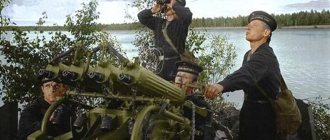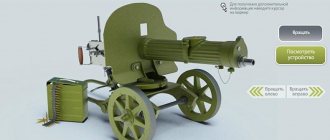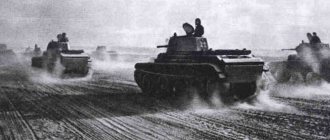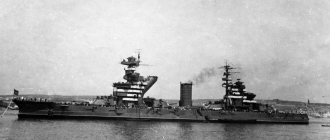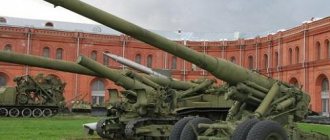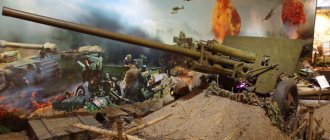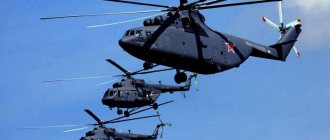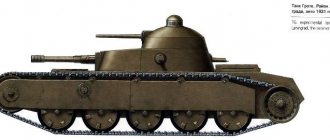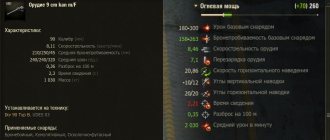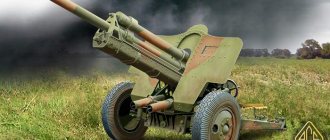Modules
| Penetration (mm) | Damage (HP) | Rapid fire (rounds/min) | Spread (m/100m) | Mixing (c) | Weight, kg) | Price (|) | ||
| VII | 122 mm D2-5T | 175/217/61 | 390/390/465 | 4.07 | 0.46 | 3.43 | 2600 | 84980 |
| VII | 100 mm D-10T | 175/235/50 | 230/230/330 | 7.44 | 0.42 | 2.86 | 2257 | 78180 |
| VIII | 122 mm D-25T | 175/217/61 | 390/390/465 | 4.86 | 0.46 | 3.43 | 2590 | 125140 |
| IX | 122 mm BL-9 | 225/265/68 | 390/390/465 | 4.53 | 0.4 | 3.43 | 2790 | 178500 |
| Armor (mm) | Rotation (gr/sec) | Review (m) | Weight, kg) | Price (|) | ||
| VIII | Kirovets-1 | 150/90/80 | 28 | 332.5 | 11200 | 30000 |
| VIII | IS-3 | 220/110/110 | 26.25 | 350 | 11500 | 31500 |
| Power (hp) | Fire probability (%) | Weight, kg) | Price (|) | ||
| VIII | AT 11 | 650 | 15 | 750 | 55270 |
| IX | V-2-54IS | 700 | 12 | 700 | 79290 |
| Max. load (t) | Turning speed (gr/sec) | Rmin | Weight, kg) | Price (|) | ||
| VII | IS-3 | 50.56 | 27 | B/2 | 10000 | 17780 |
| VIII | IS-3M | 53.9 | 30 | B/2 | 10000 | 31450 |
| Communication range (m) | Weight, kg) | Price (|) | ||
| VII | 10RK | 440 | 100 | 18600 |
| IX | 12RT | 625 | 110 | 33600 |
| X | P113 | 730 | 80 | 52200 |
IS-3 in the game
Research and leveling
Initial state of the IS-3 tree
Researched on the IS tank for 77,000 experience. After the IS (after examining all modules) there should be 122 mm D2-5T and D-25T guns, 100 mm D-10T, V-2-54IS engine and 12RT radio. Patch 0.7.0 made it possible to install absolutely all modules on the stock chassis.
Leveling up with top IP:
- The BL-9 gun costs 44,000, giving a 30% increase in penetration (225mm for the BL-9 and 175mm for the D-25T) and significantly increased accuracy (0.35 versus 0.4) with a slight decrease in the rate of fire.
- The second module to choose from is the IS-3 turret for 14625, which increases the tank’s protection, visibility and HP, or the IS-3M chassis for 14200, which improves maneuverability and allows the installation of the heaviest equipment.
- Radio R113 for 8700
- IS-8 tank for 164,700.
When researching on an IS tank, pumping only the necessary modules (D2-5T, D-10T)
- IS-3M chassis
- The 122 mm D-25T gun for 19,000 has a higher rate of fire compared to the D2-5T.
- IS-3 turret
- 122 mm BL-9 gun
- The V-2-54IS engine for 26,000 improves the mobility of the tank.
- Walkie-talkie 12RT for 5600.
- Radio P113.
- IS-8 tank for 164,700.
Combat effectiveness
Since both in real life and in the game the IS-3 is a development of the IS tank (IS-2), the style of play will be approximately the same - support at medium and close range, breaking through directions with weak defense, flank attacks and base defense.
Improved armor compared to the previous tank in the branch allows you to go one-on-one with “classmates” like the Royal Tiger and T32 and tanks of a lower level, but you should not consider the IS-3 the best because in a fight between the IS-3 and, for example, the T32 Not only the armor is important, but also the dynamic characteristics of the tank, as well as the power and rate of fire of the gun (there is no need to talk about penetration - all the guns of the eighth and most of the seventh can penetrate the IS-3 into the front of the hull).
If we compare the IS-3 and the Koenigtiger, the IS-3 beats the Tiger in damage per shot, maneuverability and speed, but at the same time the Tiger has a better viewing range, better accuracy and rate of fire, and also has HP reserves at the top. Don’t forget that the German tank has the ability to turn on the spot.
In the event of a fight between the IS-3 and T32, the tank that hits the enemy first usually wins. Sometimes the top gun of the T32 does not penetrate the IS-3, which gives the latter a chance to destroy the enemy without a greater loss of HP. But you shouldn’t always count on this, because the T32 has a much greater elevation angle than the IS-3, which gives it the opportunity to shoot vulnerable points on the IS-3 hull from behind a hillock, while the IS-3 itself cannot lower the gun below the turret and will be forced to move closer and open up even more weak points for the enemy (for example: the lower armor plate). Therefore, it is worth luring the T32 into an open area, where the IS-3 could calmly shoot it in the body.
With VK 4502 (P) Ausf. And the situation is approximately the same, except that it is worth mentioning the much thinner armor of the turret, which can be penetrated with a probability of 90%, as well as slightly better maneuverability and rate of fire compared to the IS-3, which gives it the opportunity to go aboard.
As for the AMX 50 100, this tank is the most dangerous. Its top gun has a penetration of 232mm, which is enough even to penetrate the IS-3 turret in some places, and the fast reloading of shells in the drum with 300 HP damage and good mobility makes it possible to fire only 5 shells to destroy the IS-3. But the IS-3 can also penetrate it anywhere on the hull and turret. Don’t forget about the reloading of the drum of the AMX 50 100, which gives it some advantages over it.
In a fight with the KV-5, it is important not to exchange fire close head-on, allowing the KV-5 to realize its rate of fire in numerous vulnerable areas into which it is capable of penetrating the IS-3 from the front. The simplest “swing” from behind cover, combined with positioning at an angle, allows you to destroy the KV-5 with virtually no damage.
With Lowe the situation is the opposite - its powerful gun is deadly at long range. It is completely impossible to rely on the IS-3 armor here. Therefore, it is necessary to impose a close maneuverable battle, even to the point of “spinning” in the manner of a medium tank - the clumsy Lev, which is, in addition, noticeably inferior to the IS-3 in terms of overall damage rate, will find it difficult to survive such a duel.
The length of the hull does not allow you to hide behind small houses, but the tank has a low silhouette, so you can hide from artillery behind low mountains. Due to the small VN angle (vertical aiming), you have to completely show the enemy the thin side of the hull and turret, and the low visibility does not allow you to see a hidden tank destroyer before being detected yourself, however, good maneuverability and high speed allow you to quickly escape from under fire and take up defensive positions.
Advantages:
- The frontal part of the body has good angles of inclination.
- Low profile of the tank.
- The fast turret traverse speed and chassis rotation allow you to keep medium and top French tanks in your crosshairs.
- Relatively high speed and sufficient maneuverability for a heavy tank.
- The 122 mm BL-9 gun, which allows you to penetrate everything, including Maus.
- Small tower hatches.
- Availability of 30mm screens.
- Good top-end radio.
Flaws:
- A large number of vulnerable spots in the frontal part, vulnerable stern.
- Expensive ammunition and repairs.
- Low viewing range compared to other tier 8 tanks.
- The smallest HP reserve among tier 8 heavy tanks.
- Small elevation angle.
Upgrading the crew
Commander: Repair, Mentor, Combat Brotherhood
Gunner:Repair,Sniper,Smooth turret rotation,Combat brotherhood
Driver mechanic: Repair, Cleanliness and order (often on fire), Military brotherhood
Loader: Repair, Non-contact ammo rack (often crits ammo rack), Combat brotherhood
Equipment, equipment and ammunition
Equipment:
- Reinforced aiming drives
- Large caliber gun rammer
- Vertical Stabilizer Mk2 or Improved Ventilation Class 3
Standard equipment:
- First aid kit
- Repair kit
- Fire extinguisher
You can take Lend-Lease oil if you don’t mind paying 5,000 credits for each battle.
Ammunition:
From the ammunition load with the top BL-9T cannon, armor-piercing shells are best suited due to the high penetration of the gun, but nevertheless, high-explosive fragmentation shells are necessary when meeting with more armored tanks or for combat at long distances. The best ratio is 23 armor-piercing and 5 high-explosive shells.
BB24BP0OF6
Known Issues
Model errors (see pictures below)
- On the model, the upper frontal plates of the “pike” nose have small bends (shown in red lines in the figure); on the real IS-3, the armor in this place was smooth, without bends.
Inconsistencies with the historical prototype
- The BL-9 and D-10T guns were not installed on the IS-3.
- The D2-5T gun does not exist; in addition, it uses a model from the D-25T.
- The maximum speed was 40 km/h, in the game - 38 km/h.
- The weight was 46.5 tons instead of 48.68 tons.
- The turret's armor diverges slightly on the sides and rear, ranging from 220 at the bottom of the turret to 110 at the top of the turret and up to 255 mm of armor on the front. This was done due to the fact that when armor was converted into a game parameter, the tank literally became indestructible. I had to cut it off.
Screenshot gallery
IS-3 assessment
- Warrior - for a powerful weapon with high penetration and good armor
- Steel wall - tanks up to level 7, for the most part, do not penetrate the armor of the IS-3
- Sniper - for high accuracy of gunfire.
- Death Scythe - for high weapon damage.
- Armor-piercer - for the high penetration of the BL-9 gun
Stalin's "mouse beaters"
Weapon designers are always driven by the desire to be at least half a step ahead of their competitors. The creators of tank armor strive to provide the crews of combat vehicles with maximum protection from fire from all existing types of guns, and the designers of anti-tank artillery systems strive to create guns capable of penetrating the armor of any modern tank. But in the spring of 1941, work began in the Soviet Union on a 107 mm anti-tank gun, a worthy purpose for which would appear only a few years later. Both these guns and their probable opponents from among the German tanks were embodied in metal. But neither one nor the other was destined to end up on the battlefield.
Shadow Fighting Gun
By the beginning of 1941, Soviet anti-tank artillery was developing in several directions at once. The 57-mm F-31 anti-tank gun, later designated ZIS-2, was considered the most promising at that time. The gun was developed at Factory No. 92 under the leadership of V.G. Grabin. In parallel with it, the development of a “76-mm powerful anti-tank gun based on the USV” was underway, which had the factory designation F-26. It was created with great difficulties. Due to problems with the recoil brake, the gun was rebuilt several times. Finally, at the beginning of January 1941, on Grabin’s initiative, an 85-mm anti-tank gun was also manufactured. It was based on the carriage of an experimental 95-mm F-25 divisional gun with elongated frames. In January, 225 shots were fired from it.
On March 11, 1941, the head of the Intelligence Directorate of the General Staff of the Red Army, Lieutenant General F. I. Golikov, prepared a special message “On the direction of development of the German armed forces and changes in their condition.” According to this document, German industry began building three types of heavy tanks. The most powerful of them, designated Type VII, allegedly weighed 90 tons and was armed with a 105 mm cannon. The country's military leadership took this information extremely seriously. The planned production launch of the T-150 tank, which was to be called the KV-3, was cancelled. Instead, they began to develop a completely different vehicle based on the experimental T-220 tank. The new KV-3 was supposed to be armed with a 107 mm cannon, have armor about 120 mm thick and a combat weight of 67–68 tons. Moreover, in parallel, the development of even heavier tanks KV-4 and KV-5 was launched.
Draft design of a 107 mm anti-tank gun UML-20, July 1941
The matter was not limited to tanks alone. By April 18, 1941, a decree of the Council of People's Commissars of the USSR and the Central Committee of the All-Union Communist Party of Bolsheviks was prepared “On tank weapons, a new anti-tank gun, self-propelled artillery units and armor-piercing shells.” In the context of this article, the most interesting is the sixth paragraph of this resolution:
"6. By a powerful 107 mm hull gun.
Instruct the NKV to develop and manufacture at factories No. 172 and No. 92 prototypes of placing a 152 mm howitzer-gun model 1937 on a carriage with a powerful 107 mm barrel with an initial speed of 1100 m/sec.
The deadline for delivery of prototypes to NPOs is July 1, 1941.
By the same deadline, produce a prototype of a self-propelled 107 mm gun with the specified ballistics. The installation will be carried out by NKTM on an extended chassis of the KV-4 tank (60 mm armor).
The NKB will develop and produce by the specified date a shot for this gun with a solid armor-piercing projectile with a tracer, with a phlegmatizer and a decoupler in a charge of 3,000 pieces.”
The self-propelled gun mentioned in the resolution was to be developed jointly with the SU-B-13, as well as the self-propelled gun “212”. The design of the SU-B-13, judging by the decree, began, it even reached the preliminary design, tactical and technical requirements were drawn up, but that was all. The production of the 212 self-propelled guns stalled at the stage of manufacturing body parts. In contrast, the self-propelled gun with an anti-tank gun did not even reach the stage of tactical and technical requirements. But with the “powerful 107-mm hull gun” itself, things have progressed much further.
Calculation of the UML-20 barrel. Unlike this gun, graphic materials on the ZIS-23 and ZIS-24 have not survived to this day.
According to initial calculations, the new “powerful gun” with an initial projectile speed of 1100 m/s was supposed to penetrate 188 mm thick armor at a distance of a kilometer, installed at an angle of 30 degrees. By the beginning of May the characteristics had been adjusted. According to calculations for the 107-mm anti-tank gun, which received the factory index ZIS-24, the initial velocity of the projectile was reduced to 1020 m/s, while the barrel length should have been around 60 calibers. However, these data were not final.
Meanwhile, Grabin once again took the initiative and at the same time began developing a lighter alternative for the ZIS-24. The gun, which received the factory designation ZIS-23, was developed using the carriage of the 107-mm M-60 divisional gun. According to preliminary calculations, the initial speed of its projectile was supposed to reach 1150 m/s, and the barrel length was estimated at approximately 70 calibers.
The development of tactical and technical requirements (TTT) for heavy-duty anti-tank guns has been delayed. The consideration of the draft tactical and technical requirements by the Artillery Committee of the GAU KA took place on May 22, 1941. According to the accepted technical specifications, the initial velocity of the 107-mm cannon projectile was kept at 1020 m/s. A projectile weighing 18.8 kg was supposed to penetrate at a distance of a kilometer an armor plate 160 mm thick, installed at an angle of 30 degrees. The barrel length was limited to 70 calibers. The rate of fire was set at 10 rounds per minute, and loading had to be unitary. When developing the gun, the maximum use was made of the carriage of the 152-mm ML-20 howitzer-gun, which included its sighting devices. Along with anti-tank functions, the gun was also supposed to play the role of a hull gun, for which its ammunition included a high-explosive fragmentation projectile with an initial speed of 730 m/s and a mass of 18.8 kg.
Draft design of the 107 mm M75 anti-tank gun
On the same day, the requirements for the “85-mm special-purpose anti-tank gun” were approved. It, in turn, was supposed to perform the function of a divisional gun, for which purpose the ammunition load included high-explosive fragmentation ammunition weighing 9.2 kg with an initial speed of 800 m/s. As for its armor-piercing projectile, it had an initial speed of 1150 m/s and a mass of 10.5 kg. At a distance of a kilometer, this projectile also had to penetrate a 160 mm thick armor plate installed at an angle of 30 degrees. As a base for the TTT gun, it was planned to use the carriage of the 107-mm M-60 cannon. Changes to the design of the base were planned to be minimal; in particular, it was planned to create a new gun shield.
Heavyweight competition
Until the beginning of June 1941, work on the design of heavy-duty anti-tank guns was actually carried out only by plant No. 92, despite the fact that the decree referred to two plants. This situation can be explained by the fact that Grabin showed initiative, which was noticed at the top. However, plant No. 172 at that moment was a little uneasy: it already had a large volume of orders for howitzer artillery, as well as artillery of the Reserve of the High Command (RGK).
The “sharing” of requirements for guns continued at the end of May and beginning of June 1941. As a result, the final version of the requirements was sent to factories only by June 7. At the same time, by the time the final specifications were received, plant No. 172 had already begun work on creating its own 107-mm anti-tank gun. The latest edition of the requirements put the plant in an awkward position, since they included instructions on the use of a mechanical rammer, as well as on rifling of the barrel of progressive steepness. In a letter to the chairman of the Artcom of the GAU KA, Major General Khokhlov, the acting director of the plant, Kudryavtsev, indicated that the design bureau would develop a new gun without these elements. According to the design bureau, a rate of fire of 10 rounds per minute could be achieved without a rammer. The gun, developed by the team at Plant No. 172, received the M75 index. According to preliminary calculations, the initial speed of its projectile was supposed to be 1020 m/s, while armor penetration was assumed to be at the level specified in the technical specifications.
The gun shield, according to the requirements, had to be installed on all projects of heavy-duty anti-tank guns
It is interesting that in Molotov (modern Perm), where plant No. 172 was located, the development of an 85-mm anti-tank gun began, about which only fragmentary information was received. Information about it first surfaces in mid-June 1941. In the correspondence that went on between the People's Commissariat of Ammunition and Plant No. 172, it turned out that the monitor-test shells intended for the 85-mm ZIS-23 gun were not enough for the weapon developed by Plant No. 172. For this reason, it was necessary to produce another 300 shells: 50 by July 5, and the remaining 250 by July 15, 1941. In further correspondence regarding ammunition, the factory index of the new gun was discovered - M-76. It also states that plant No. 172 has obtained government permission to manufacture a prototype.
It was not possible to find any tactical and technical characteristics for the M-76. As for the 85-mm ZIS-23 cannon competing with it, its tactical and technical characteristics (TTX) were finally approved by the beginning of July 1941. To ensure an initial speed of 1150 m/s, the gun received a barrel with a length of 96.8 calibers (8228 mm). The ZIS-24 did not fit into the TTT in terms of barrel length. According to the final performance characteristics, the total length of its barrel was 73.5 calibers, or 7843 mm.
The performance data dated July 4, 1941 indicated that the guns were designed by Factory No. 92 and are in the process of producing prototypes. Whether these guns were made or not - history is silent. But as of July 31, 1941, both guns were still not at the manufacturing stage, but at the design stage. By August 15, Plant No. 92 should have already delivered two prototypes of the ZIS-23 (work on the ZIS-24 was now only going on on an initiative basis). This did not happen within the specified time frame; moreover, both guns are missing from the report on the experimental work of plant No. 92, dated August 25. There is no information on them in subsequent documents. Thus, there is a high degree of probability that neither the ZIS-23 nor the ZIS-24 were ever manufactured.
M75 during testing, October 1941
Quite unexpectedly, a third participant intervened in the competition. On July 7, 1941, a letter from Sverdlovsk was sent to the head of the Directorate for Orders and Production of Ground Artillery Weapons (UVNA). The authors of the letter were the chief engineer of the Ural Heavy Engineering Plant (UZTM) A. S. Ryzhkov, the head of the plant's design bureau A. N. Bulashev, as well as the chief designer F. F. Petrov (one of the creators of the ML-20 gun). The letter from Uralmash proposed a preliminary design for an anti-tank gun, designated UML-20.
The highlight of the project was the maximum unification of the gun with samples already in production, namely the ML-20 and A-19. It was planned to take the piston bolt from the A-19, and the barrel casing was also taken from it. The breech and carriage were used from the ML-20. In addition, it was supposed to take a cartridge case from the A-19. The possibility of using a projectile from the M-60 was even suggested, but doubts arose whether it would withstand the increased pressure. The initial velocity of the projectile was estimated at 1050 m/s, while the barrel length was supposed to be 59.5 calibers. In order to compensate for the change in the center of gravity, the barrel was extended back by 235 mm.
The same gun in firing position
UZTM's proposal seemed quite reasonable. Thanks to the maximum use of parts already in production, it was possible to speed up the development, and most importantly, the launch of the gun into series. But the history of UML-20 did not advance beyond the preliminary design.
As a result, the only super-powerful anti-tank gun that reached the testing stage was the M75, developed under the leadership of S. N. Dernov.
Without worthy goals
Technical documentation for the 107-mm M75 anti-tank gun was prepared by Plant No. 172 by the end of June 1941. It is worth noting that the beginning of the Great Patriotic War did not initially affect its development. Unlike work on the promising heavy tanks KV-3, KV-4 and KV-5, the development of a heavy-duty anti-tank gun was not curtailed. Plant No. 172 began production of two prototypes of the M75 at the beginning of July 1941, and by the end of the month they were already undergoing factory tests. During test firing, initial projectile velocities from 1017 to 1047 m/s were obtained, which met the specified requirements. No breakage of the leading belts on the projectiles was observed. The holes in the shield had the shape of a circle, that is, when fired, the shells flew steadily. The main problem during factory tests was the operation of semi-automatic equipment. This was due to the materials from which the wedge and breech were made
On July 15, a technical design of the gun, developed in parallel with the production of prototypes, was sent to the head of the UVNA, military engineer 1st rank Komarov. In general, the gun met the requirements. The initial velocity of its projectile was 1020 m/s, the barrel length was 70.5 calibers (7550 mm), and the design used an ML-20 carriage. However, a resolution was imposed on the project:
“instead of applying a new 107 mm barrel to the ML_20 carriage, the plant began an unsuccessful “modernization” of this carriage, common to the ML-20 and the 122 mm gun model 1931/37.”
A more detailed version of the resolution was sent to plant No. 172 on July 28, 1941, signed by the head of the GAU KA, Colonel General Yakovlev.
Despite the requirements to make maximum use of the ML-20 carriage, experienced M75s had a lot of changes in its design
This reaction from the leadership of the GAU KA was caused by the changes that were made to the design of the carriage at plant No. 172. Instead of the standard system for transferring the barrel from the combat position to the traveling position, a chain hoist similar to that used in the M-60 was used. In addition to changing the design, the GAU expressed fair doubts about speeding up the procedure for transferring the barrel from the firing position to the stowed position and vice versa. It turned out to be much more significant that for the M75 the designers changed the recoil system, and also actually made a new front end. In conditions of war and the expected appearance of German heavy tanks at the front, this state of affairs was rightly recognized as unacceptable. Serial M75s were supposed to be manufactured on a standard ML-20 carriage and with a standard limber.
It was decided to carry out further tests of the M75 at the Ural Artillery Range (now the Nizhny Tagil Institute for Metal Testing (NTIIM)). The test program was approved on August 16, 1941. During the tests, the strength of the system, its ballistic properties were checked and armor penetration was determined. The same prototypes that underwent factory testing were presented for testing. System number 1 had pipe number 4 with a rifling stroke length of 25 calibers, and system number 2 had pipe number 7 with a rifling length of 32 calibers. Also delivered with the guns was pipe No. 5, whose rifling length was 32 calibers.
The gun is in stowed position. Instead of the standard system for transferring the barrel from the combat position to the traveling position, a chain hoist was used, as on the M-60
Documentation for the guns was delivered on August 28, but testing began only a month later, on September 29. The first stage was the disassembly and reassembly of the systems, during which the barrels on the guns were swapped. The tests were complicated by the fact that the Ural artillery range was not adapted to a whole range of necessary work.
The first shooting began only on October 5. The fire came from system No. 1. On October 16, after 105 shots, at the suggestion of plant No. 172, the tests were suspended. This was due to the need to manufacture a new wedge and a number of other parts. Testing resumed on November 3. After 402 shots, due to the large development of the rifled part of the barrel bore, pipe No. 5 was replaced with pipe No. 4. Firing tests were completed on December 11, but due to being busy testing other systems, a report on them was compiled only by January 2, 1942.
The gun in firing position, front view
The overall conclusions from the trials were extremely mixed. Firstly, the survivability of the pipe was determined to be only 250–300 shots, which was clearly insufficient. Secondly, serious problems arose with armor penetration. The cannon pierced a sheet 152 mm thick, but this happened at a distance of only 100 meters. At a distance of a kilometer, shelling was not even carried out, since the shells of the shells turned out to be fragile.
However, this was a chronic problem with Soviet armor-piercing shells for most systems in service, and it was not immediately possible to solve it. The real rate of fire of the gun turned out to be only 5–6 rounds per minute. There were big problems with the extraction of cartridges. As a result, the M75 was declared unable to pass the test.
Ammunition range for the 107 mm M75 gun
Plant No. 172, of course, could potentially bring the M75 to fruition. Many guns, including anti-tank ones, had similar problems. The progress of the tests showed how the identified deficiencies can be eliminated. In addition, as mentioned above, the Ural artillery range was not adapted for full-fledged testing, and many of the problems that arose at the range could be solved in the factory conditions. However, on April 22, 1942, a verdict was issued to stop work on heavy-duty anti-tank guns:
“Since the experience of the previous war did not confirm the need to use this kind of guns to fight tanks, I consider it inappropriate to further refine the M-75 gun and its ammunition in order to eliminate all the shortcomings.
Reporting the above, I ask for your permission to stop all work on the 107 mm M-75 anti-tank gun and similar work at the State Order of Lenin Plant No. 92 named after. Stalin with 85 mm and 107 mm anti-tank guns “ZIS-23” and “ZIS-24”.
107-mm shells penetrated armor, but at the same time split upon impact
People's Commissar of Armaments, Colonel General Voronov, who wrote this letter to Stalin, did not know that it was at this very time that Ferdinand Porsche's design bureau began developing a super-heavy tank, against which Soviet heavy-duty anti-tank guns were created. To the front, however, neither VK 100.01, nor even Pz.Kpfw. Maus never arrived. However, the M75 was remembered again - in 1943.
M75 cannon No. 1 that has survived to this day. The site of military equipment of the future Museum of the Armed Forces of the Republic of Kazakhstan in Astana
In July 1943, another creation of Porsche KG, the self-propelled Ferdinand, debuted near Ponyry. Her appearance in the Red Army was taken very seriously. Among the list of works on tank, anti-tank and self-propelled artillery, dated September 15, 1943, the M75 reappeared. One of the reasons for the return of the project abandoned in 1942 was that the gun was based on the carriage of the ML-20 howitzer gun. The idea of arming a self-propelled gun with an M75 cannon, buried in the summer of 1941, two years later received a chance to return, especially since worthy goals finally appeared for it.
However, the return to the topic of the 107-mm anti-tank gun turned out to be extremely short-lived. In the same letter where the M75 was mentioned, the Chairman of the Artillery Committee of the GAU KA, Major General Khokhlov, proposed abandoning a number of projects, replacing them with more promising 122-mm guns with an initial projectile speed of 1000 m/s.
Sources and literature:
- TsAMO RF
- Photo album “History of KBM”, 1967
- https://sovetarmy.2×2forum.com
